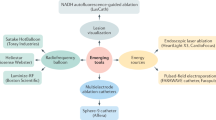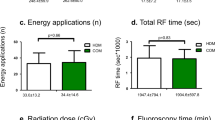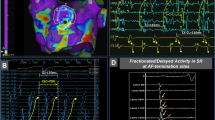Abstract
Over the past 5 years, catheter ablation of atrial fibrillation (AF) has evolved from being an experimental procedure to one that is performed in most large medical centers throughout the world. The rapid and widespread acceptance of this procedure reflects encouraging reports of the safety and efficacy of a pulmonary vein (PV) approach, which has 70–80% efficacy and around a 5% risk of major complications. Currently three PV-based ablation strategies are employed for catheter ablation of AF, termed segmental PV isolation, circumferential PV ablation and circumferential PV isolation. Three main research activities are ongoing in the field of catheter ablation of AF. One aim is to better define the safety and efficacy of AF ablation using the three approaches listed. The second research focus is to improve safety and efficacy by the development of new mapping and ablation tools. And the third major area of research is the development of new strategies for AF ablation. It is highly likely during the next 5 years that catheter ablation of AF will become a routine and well-accepted treatment strategy for this common arrhythmia condition.
This is a preview of subscription content, access via your institution
Access options
Subscribe to this journal
Receive 12 print issues and online access
$209.00 per year
only $17.42 per issue
Buy this article
- Purchase on Springer Link
- Instant access to full article PDF
Prices may be subject to local taxes which are calculated during checkout



Similar content being viewed by others
References
Swartz JF et al. (1994) A catheter-based curative approach to atrial fibrillation in humans. Circulation 90 (suppl): I–335
Haissaguerre M et al. (1994) Successful catheter ablation of atrial fibrillation. J Cardiovasc Electrophysiol 5: 1045–1052
Haissaguerre M et al. (1996) Right and left atrial radiofrequency catheter therapy of paroxysmal atrial fibrillation. J Cardiovasc Electrophysiol 7: 1132–1144
Haissaguerre M et al. (1994) Radiofrequency catheter ablation in unusual mechanisms of atrial fibrillation: report of three cases. J Cardiovasc Electrophysiol 5: 743–751
Jais P et al. (1997) A focal source of atrial fibrillation treated by discrete radiofrequency ablation. Circulation 95: 572–576
Haissaguerre M et al. (1998) Spontaneous initiation of atrial fibrillation by ectopic beats originating in the pulmonary veins. N Engl J Med 339: 659–666
Chen SA et al. (1999) Initiation of atrial fibrillation by ectopic beats originating from the pulmonary veins: electrophysiological characteristics, pharmacological responses, and effects of radiofrequency ablation. Circulation 100: 1879–1886
Lau CP et al. (1999) Defibrillation-guided radiofrequency ablation of atrial fibrillation secondary to an atrial focus. J Am Coll Cardiol 33: 1217–1226
Oral H et al. (2002) Pulmonary vein isolation for paroxysmal and persistent atrial fibrillation. Circulation 105: 1077–1081
Vasamreddy CR et al. (2004) Predictors of recurrence following catheter ablation of atrial fibrillation using an irrigated-tip ablation catheter. J Cardiovasc Electrophysiol 15: 692–697
Haissaguerre M et al. (2000) Electrophysiological breakthroughs from the left atrium to the pulmonary veins. Circulation 102: 2463–2465
Marrouche NF et al. (2002) Circular mapping and ablation of the pulmonary vein for treatment of atrial fibrillation: impact of different catheter technologies. J Am Coll Cardiol 40: 464–474
Deisenhofer I et al. (2003) Circumferential mapping and electric isolation of pulmonary veins in patients with atrial fibrillation. Am J Cardiol 91: 159–163
Arentz T et al. (2003) Feasibility and safety of pulmonary vein isolation using a new mapping and navigation system in patients with refractory atrial fibrillation. Circulation 108: 2484–2490
Oral H et al. (2003) Catheter ablation for paroxysmal atrial fibrillation: segmental pulmonary vein ostial ablation versus left atrial ablation. Circulation 108: 2355–2360
Mansour M et al. (2004) Efficacy and safety of segmental ostial versus circumferential extra-ostial pulmonary vein isolation for atrial fibrillation. J Cardiovasc Electrophysiol 15: 532–537
Zrenner B et al. (2004) Is circumferential pulmonary vein ablation superior to electrical pulmonary vein isolation for treatment of paroxysmal atrial fibrillation? In Proceedings of Heart Rhythm 2004: 25th Annual Scientific Sessions, May 19–22; San Francisco.
Vasamreddy CR et al. (2005) Safety and efficacy of circumferential pulmonary vein catheter ablation of atrial fibrillation. Heart Rhythm 2: 42–48
Dong J et al. Incidence and predictors of pulmonary vein stenosis following catheter ablation of atrial fibrillation using the anatomic pulmonary vein ablation approach: results from paired magnetic resonance imaging. J Cardiovasc Electrophysiol, in press
Pappone C et al. (2001) Atrial electroanatomic remodeling after circumferential radiofrequency pulmonary vein ablation: efficacy of an anatomic approach in a large cohort of patients with atrial fibrillation. Circulation 104: 2539–2544
Kottkamp H et al. (2004) Time courses and quantitative analysis of atrial fibrillation episode number and duration after circular plus linear left atrial lesions: trigger elimination or substrate modification: early or delayed cure? J Am Coll Cardiol 44: 869–877
Pappone C et al. (2004) Prevention of iatrogenic atrial tachycardia after ablation of atrial fibrillation: a prospective randomized study comparing circumferential pulmonary vein ablation with a modified approach. Circulation 110: 3036–3042
Pappone C et al. (2004) Atrio-esophageal fistula as a complication of percutaneous transcatheter ablation of atrial fibrillation. Circulation 109: 2724–2726
Scanavacca MI et al. (2004) Left atrial-esophageal fistula following radiofrequency catheter ablation of atrial fibrillation. J Cardiovasc Electrophysiol 15: 960–962
Ouyang F et al. (2004) Complete isolation of left atrium surrounding the pulmonary veins: new insights from the double-Lasso technique in paroxysmal atrial fibrillation. Circulation 110: 2090–2096
Marrouche NF et al. (2003) Phased-array intracardiac echocardiography monitoring during pulmonary vein isolation in patients with atrial fibrillation: impact on outcome and complications. Circulation 107: 2710–2716
Arentz T et al. Effects of circumferential ostial radiofrequency lesions on pulmonary vein activation recorded with a multipolar basket catheter. J Cardiovasc Electrophysiol (in press)
Page RL et al. (1994) Asymptomatic arrhythmias in patients with symptomatic paroxysmal atrial fibrillation and paroxysmal supraventricular tachycardia. Circulation 89: 224–227
Pappone C et al. (2003) Mortality, morbidity, and quality of life after circumferential pulmonary vein ablation for atrial fibrillation: outcomes from a controlled nonrandomized long-term study. J Am Coll Cardiol 42: 185–197
Tse HF et al. (2003) Pulmonary vein isolation using transvenous catheter cryoablation for treatment of atrial fibrillation without risk of pulmonary vein stenosis. J Am Coll Cardiol 42: 752–758
Meininger GR et al. (2003) Initial experience with a novel focused ultrasound ablation system for ring ablation outside the pulmonary vein. J Interv Card Electrophysiol 8: 141–148
Faddis MN et al. (2002) Novel, magnetically guided catheter for endocardial mapping and radiofrequency catheter ablation. Circulation 106: 2980–2985
Faddis MN et al. (2003) Magnetic guidance system for cardiac electrophysiology: a prospective trial of safety and efficacy in humans. J Am Coll Cardiol 42: 1952–1958
Ernst S et al. (2004) Initial experience with remote catheter ablation using a novel magnetic navigation system: magnetic remote catheter ablation. Circulation 109: 1472–1475
Dickfeld T et al. (2003) M Anatomic stereotactic catheter ablation on three-dimensional magnetic resonance images in real time. Circulation 108: 2407–2413
Dickfeld T et al. (2004) Stereotactic magnetic resonance guidance for anatomically targeted ablations of the fossa ovalis and the left atrium. J Interv Card Electrophysiol 11: 105–115
Reddy VY et al. (2004) Integration of cardiac magnetic resonance imaging with three-dimensional electroanatomic mapping to guide left ventricular catheter manipulation: feasibility in a porcine model of healed myocardial infarction. J Am Coll Cardiol 44: 2202–2213
Sra J VY et al. (2005) Feasibility and validation of registration of three-dimensional left atrial models derived from computed tomography with a noncontact cardiac mapping system. Heart Rhythm 2: 55–63
Haissaguerre M et al. (2004) Changes in atrial fibrillation cycle length and inducibility during catheter ablation and their relation to outcome. Circulation 109: 3007–3013
Pappone C et al. (2004) Pulmonary vein denervation enhances long-term benefit after circumferential ablation for paroxysmal atrial fibrillation. Circulation 109: 327–334
Nademanee K et al. (2004) A new approach for catheter ablation of atrial fibrillation: mapping of the electrophysiologic substrate. J Am Coll Cardiol 43: 2044–2053
Oral H et al. (2004) Noninducibility of atrial fibrillation as an end point of left atrial circumferential ablation for paroxysmal atrial fibrillation: a randomized study. Circulation 110: 2797–2801
Author information
Authors and Affiliations
Corresponding author
Ethics declarations
Competing interests
The authors declare no competing financial interests.
Glossary
- MAZE PROCEDURE
-
A surgical procedure that cures atrial fibrillation by creating multiple incisions in the atria that interrupt the circulating wavelets
Rights and permissions
About this article
Cite this article
Dong, J., Calkins, H. Technology Insight: catheter ablation of the pulmonary veins in the treatment of atrial fibrillation. Nat Rev Cardiol 2, 159–166 (2005). https://doi.org/10.1038/ncpcardio0137
Received:
Accepted:
Issue Date:
DOI: https://doi.org/10.1038/ncpcardio0137
This article is cited by
-
Low heart deceleration capacity imply higher atrial fibrillation-free rate after ablation
Scientific Reports (2018)
-
Relevanz der Magnetresonanztomographie für die Katheterablation von Vorhofflimmern
Herzschrittmachertherapie + Elektrophysiologie (2014)
-
Einsatz der kardialen MRT in der Elektrophysiologie
Herzschrittmachertherapie + Elektrophysiologie (2012)
-
Interventionelle Elektrophysiologie in der kardialen MRT
Herz (2012)
-
Cardiovascular magnetic resonance guided electrophysiology studies
Journal of Cardiovascular Magnetic Resonance (2009)



